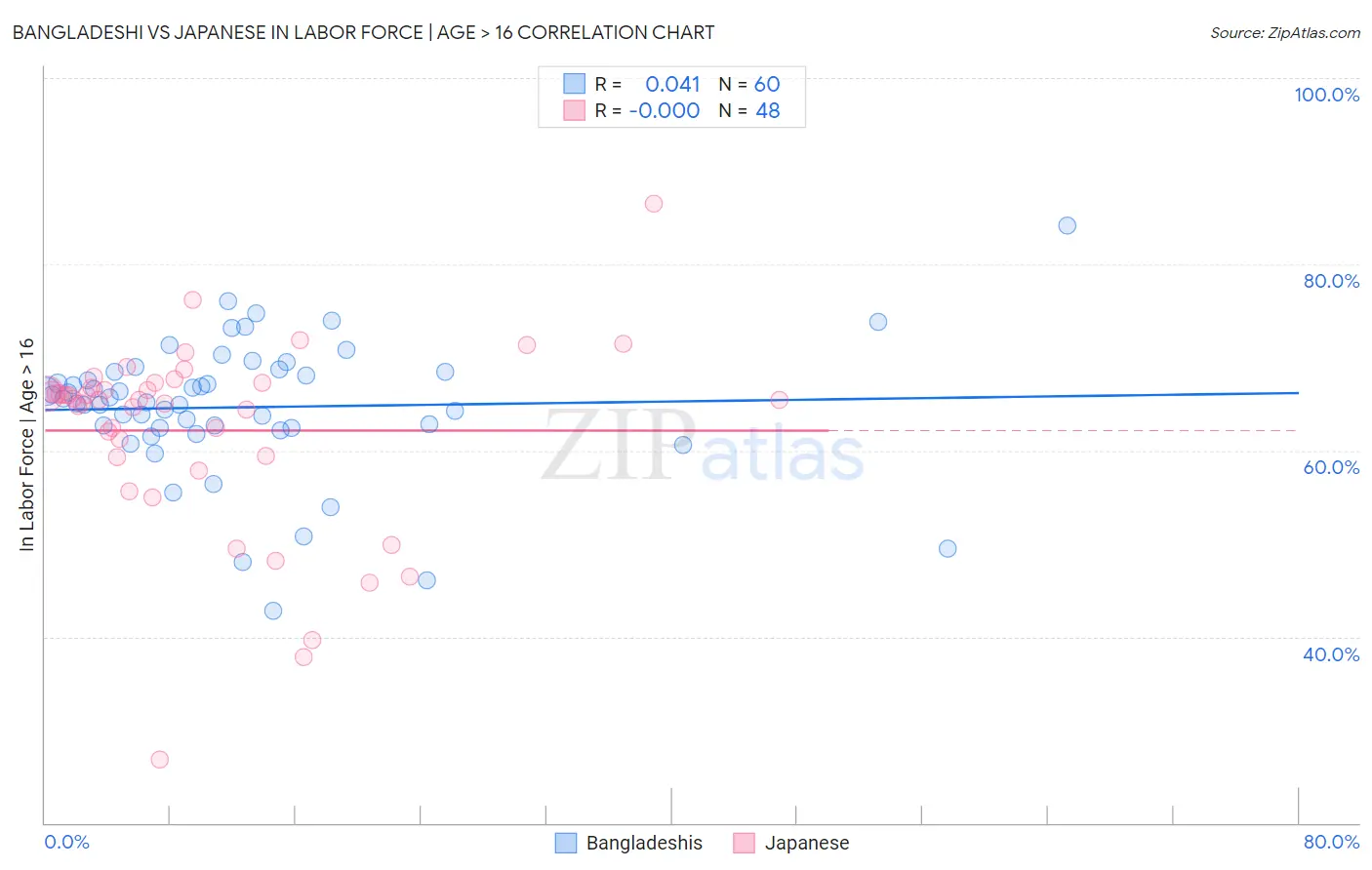Bangladeshi vs Japanese In Labor Force | Age > 16
COMPARE
Bangladeshi
Japanese
In Labor Force | Age > 16
In Labor Force | Age > 16 Comparison
Bangladeshis
Japanese
65.9%
IN LABOR FORCE | AGE > 16
98.9/ 100
METRIC RATING
96th/ 347
METRIC RANK
65.8%
IN LABOR FORCE | AGE > 16
97.7/ 100
METRIC RATING
110th/ 347
METRIC RANK
Bangladeshi vs Japanese In Labor Force | Age > 16 Correlation Chart
The statistical analysis conducted on geographies consisting of 141,452,926 people shows no correlation between the proportion of Bangladeshis and labor force participation rate among population ages 16 and over in the United States with a correlation coefficient (R) of 0.041 and weighted average of 65.9%. Similarly, the statistical analysis conducted on geographies consisting of 249,190,051 people shows no correlation between the proportion of Japanese and labor force participation rate among population ages 16 and over in the United States with a correlation coefficient (R) of -0.000 and weighted average of 65.8%, a difference of 0.20%.

In Labor Force | Age > 16 Correlation Summary
| Measurement | Bangladeshi | Japanese |
| Minimum | 42.8% | 26.8% |
| Maximum | 84.1% | 86.5% |
| Range | 41.3% | 59.7% |
| Mean | 64.7% | 62.1% |
| Median | 65.3% | 65.4% |
| Interquartile 25% (IQ1) | 62.4% | 59.4% |
| Interquartile 75% (IQ3) | 68.4% | 67.0% |
| Interquartile Range (IQR) | 6.0% | 7.6% |
| Standard Deviation (Sample) | 7.3% | 10.4% |
| Standard Deviation (Population) | 7.2% | 10.3% |
Demographics Similar to Bangladeshis and Japanese by In Labor Force | Age > 16
In terms of in labor force | age > 16, the demographic groups most similar to Bangladeshis are Filipino (65.9%, a difference of 0.010%), Immigrants from Uruguay (66.0%, a difference of 0.040%), Immigrants from Chile (65.9%, a difference of 0.040%), Immigrants from Cambodia (66.0%, a difference of 0.050%), and Immigrants from South America (66.0%, a difference of 0.060%). Similarly, the demographic groups most similar to Japanese are Immigrants from Honduras (65.8%, a difference of 0.020%), Immigrants from Spain (65.8%, a difference of 0.040%), Immigrants from Japan (65.8%, a difference of 0.040%), Laotian (65.8%, a difference of 0.040%), and Immigrants from Poland (65.8%, a difference of 0.050%).
| Demographics | Rating | Rank | In Labor Force | Age > 16 |
| Immigrants | South America | 99.1 /100 | #93 | Exceptional 66.0% |
| Immigrants | Cambodia | 99.1 /100 | #94 | Exceptional 66.0% |
| Immigrants | Uruguay | 99.1 /100 | #95 | Exceptional 66.0% |
| Bangladeshis | 98.9 /100 | #96 | Exceptional 65.9% |
| Filipinos | 98.9 /100 | #97 | Exceptional 65.9% |
| Immigrants | Chile | 98.7 /100 | #98 | Exceptional 65.9% |
| Immigrants | Australia | 98.7 /100 | #99 | Exceptional 65.9% |
| Okinawans | 98.7 /100 | #100 | Exceptional 65.9% |
| Immigrants | Colombia | 98.6 /100 | #101 | Exceptional 65.9% |
| Uruguayans | 98.6 /100 | #102 | Exceptional 65.9% |
| Immigrants | South Eastern Asia | 98.5 /100 | #103 | Exceptional 65.9% |
| Palestinians | 98.5 /100 | #104 | Exceptional 65.9% |
| Colombians | 98.4 /100 | #105 | Exceptional 65.9% |
| Immigrants | Serbia | 98.1 /100 | #106 | Exceptional 65.8% |
| Immigrants | Poland | 98.1 /100 | #107 | Exceptional 65.8% |
| Immigrants | Spain | 98.0 /100 | #108 | Exceptional 65.8% |
| Immigrants | Japan | 98.0 /100 | #109 | Exceptional 65.8% |
| Japanese | 97.7 /100 | #110 | Exceptional 65.8% |
| Immigrants | Honduras | 97.5 /100 | #111 | Exceptional 65.8% |
| Laotians | 97.4 /100 | #112 | Exceptional 65.8% |
| Pakistanis | 97.1 /100 | #113 | Exceptional 65.8% |